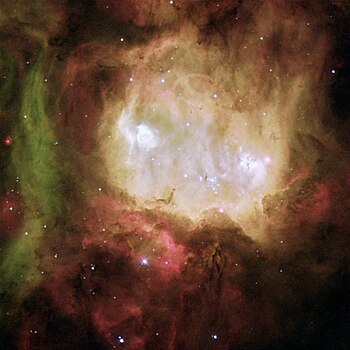NGC 2080
| Emission nebula | |
|---|---|
| NGC 2080
|
|

|
|
| Photo from the Hubble Space Telescope | |
| AladinLite | |
| Constellation | Swordfish |
|
Position equinox : J2000.0 , epoch : J2000.0 |
|
| Right ascension | 05 h 39 m 45.8 s |
| declination | -69 ° 38 ′ 39 ″ |
| Appearance
|
|
| Apparent brightness (visual) | 10.42 mag |
| Ionizing source | |
| Type | Stars of the star cluster |
| Physical data
|
|
| Affiliation | Large Magellanic Cloud (N160 Complex) |
| distance | 168,000 ly |
| diameter | 50 ly |
|
history
|
|
| discovery | John Herschel |
| Date of discovery | December 23, 1834 |
| Catalog names | |
| NGC 2080 • ESO 57-EN12 • GC 1278 • h 2950 • N160A • PKS 0540-695 | |
NGC 2080 is an emission nebula with an embedded open star cluster in the constellation Swordfish , which is about 168,000 light years from Earth , it is also known as the Ghost Head Nebula . It is located in the large Magellanic Cloud , a companion galaxy to our Milky Way, and is about 30 'south of the well-known Tarantula Nebula (30 Doradus) in the sky. It is because of its appearance and Ghost Head Nebula or German spirits Head Nebula called. The nebula is part of the N160 complex in the large Magellanic Cloud and, as an H-II region, also bears the designation N160A . Its two eyes (N160A1 and N160A2) are formed by bubbles of hydrogen and oxygen (so-called high excitation blobs, HEBs), behind which massive stars are hidden. According to astronomers , these stars are said to have formed around 10,000 years ago.
The nebula should not be confused with the objects ghost nebula (VdB 141) or small ghost nebula (NGC 6369).
The object was discovered on December 23, 1834 by the English astronomer John Herschel .
Web links
- Hubble Space Telescope
- astronews.com: A picture of oxygen and hydrogen October 19, 2001
- astronews.com: Picture of the day March 4, 2013
- GoBlack
- Halloween and the Ghost Head Nebula - Astronomy Picture of the Day from October 31, 2001.
- ESA: Painting with oxygen and hydrogen 18 October 2001
- SEDS
- Resolving the compact H II regions in N160A with HST